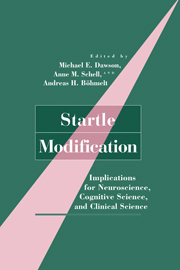Book contents
- Frontmatter
- Contents
- Contributors
- Preface
- Prologue: A Historical Note on the “Discovery” of Startle Modification
- 1 Startle Modification: Introduction and Overview
- PART I BASIC PARADIGMS, METHODS, AND PHENOMENA
- PART II PHYSIOLOGICAL MEDIATION OF STARTLE MODIFICATION
- 5 Neurophysiology and Neuropharmacology of Startle and Its Affective Modification
- 6 Neurophysiology and Neuropharmacology of Short Lead Interval Startle Modification
- PART III PSYCHOLOGICAL MEDIATION OF STARTLE MODIFICATION
- PART IV INDIVIDUAL DIFFERENCES AND STARTLE MODIFICATION
- PART V RELATIONSHIPS WITH OTHER PARADIGMS AND MEASURES
- References
- Author Index
- Subject Index
6 - Neurophysiology and Neuropharmacology of Short Lead Interval Startle Modification
Published online by Cambridge University Press: 26 March 2010
- Frontmatter
- Contents
- Contributors
- Preface
- Prologue: A Historical Note on the “Discovery” of Startle Modification
- 1 Startle Modification: Introduction and Overview
- PART I BASIC PARADIGMS, METHODS, AND PHENOMENA
- PART II PHYSIOLOGICAL MEDIATION OF STARTLE MODIFICATION
- 5 Neurophysiology and Neuropharmacology of Startle and Its Affective Modification
- 6 Neurophysiology and Neuropharmacology of Short Lead Interval Startle Modification
- PART III PSYCHOLOGICAL MEDIATION OF STARTLE MODIFICATION
- PART IV INDIVIDUAL DIFFERENCES AND STARTLE MODIFICATION
- PART V RELATIONSHIPS WITH OTHER PARADIGMS AND MEASURES
- References
- Author Index
- Subject Index
Summary
ABSTRACT
Studies of the neural basis of short lead interval startle modification have been one extension of the anatomical and behavioral “mapping” of the “primary startle circuit.” The neural substrates of prepulse inhibition (PPI) – an operational measure of sensorimotor gating – are studied partly because several neuropsychiatric disorders are characterized both by deficits in PPI and by clinical evidence of impaired inhibition of cognitive, sensory, or motor information. Brain regions implicated in the pathophysiology of these disorders – limbic cortex, ventral striatum, pallidum, and pontine tegmentum – critically regulate PPI. The neurochemistry of PPI includes neurotransmitters that subserve this circuitry, particularly dopamine, glutamate, serotonin, acetylcholine, and gamma-amino-butyric acid; specific neuropeptides also appear to regulate PPL These neural substrates have been studied via traditional neuropharmacological techniques in laboratory rats, via studies of PPI in specific patient populations, and via developmental and genetic manipulations. Collectively, these studies may identify perturbations of brain function in this circuitry that lead to deficits in PPI – such as those observed in schizophrenia and other disorders – and, conversely, what interventions might act at each level of the circuitry to enhance or restore normal levels of sensorimotor gating.
Overview: Temporal Relationships in the Phasic and Tonic Regulation of Startle
Startle response modification by short lead stimuli has been studied systematically, drawing on the tremendous strengths of startle as a quantifiable, parametrically sensitive behavior. This work has important implications for understanding fundamental principles of information processing and for examining the biological basis of specific time-linked information-processing deficits in neuropsychiatric disorders.
- Type
- Chapter
- Information
- Startle ModificationImplications for Neuroscience, Cognitive Science, and Clinical Science, pp. 114 - 134Publisher: Cambridge University PressPrint publication year: 1999
- 21
- Cited by



